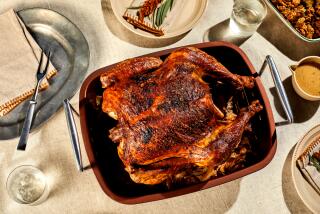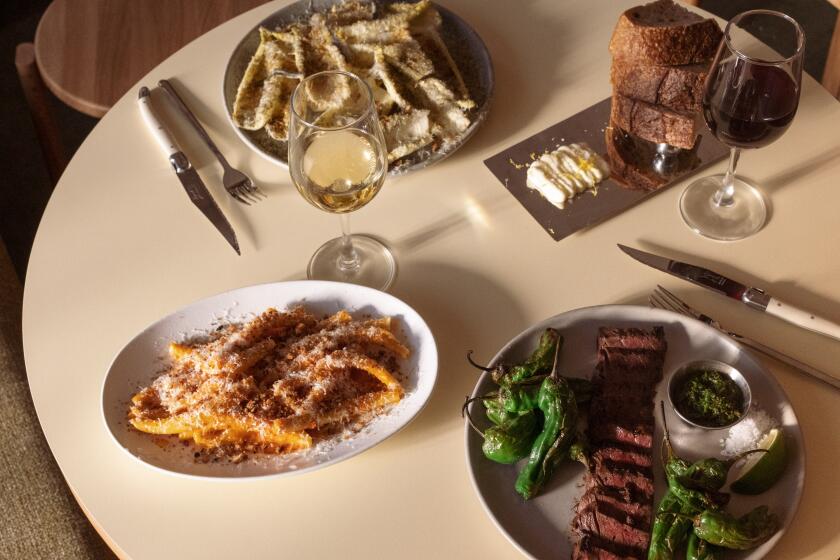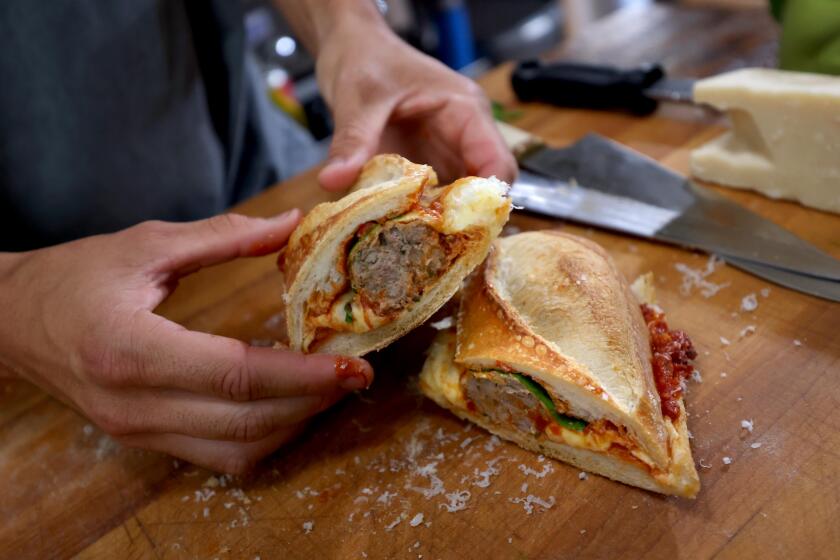Turkey Talk-Line Ready to Answer : Cooking: Butterball has a toll-free hot line in place through the holidays to ease your worries about preparing a special meal.
CHICAGO — The Butterball Turkey Talk-Line is a toll-free hot line available to callers nationwide who have questions about cooking a holiday turkey. Forty-four home economists and nutritionists are available with answers to turkey preparation questions.
The telephone number to call: 1-800-323-4848.
Talk-Line dates and hours:
-- Today, from 6 a.m. to 4 p.m.;
-- Monday through Wednesday, from 6 a.m. to 6 p.m.;
-- Thanksgiving Day, from 4 a.m. to 4 p.m.;
-- Nov. 24 through Dec. 22, Monday through Friday, from 6 a.m. to 4 p.m.
Turkey preparation tips--The New York City Health Department’s Bureau of Nutrition offers the following tips for buying and roasting a holiday turkey:
--Buying, allow 3/4 to 1 pound per serving from an 8- to 12-pound turkey. Larger birds have a larger proportion of meat to bones-- 1/2 to 1/4 pound a person should be sufficient.
--Fresh turkey, plan to roast within a day of purchase.
--Frozen turkey, purchase several days in advance to allow sufficient time for thawing.
--Thawing, leave turkey in the original wrapper. In the refrigerator, place the turkey on a shallow tray. Allow two to three days to thaw a 12- to 16-pound turkey. In cold water, place turkey in a pan or in the sink and cover with cold water. Change the water often. Allow about 1/2 hour per pound of turkey.
Thawing at room temperature is not recommended. Surface bacteria can multiply to dangerous levels at room temperatures of 60 degrees and above.
--Preparation for roasting, remove giblets. Rinse the inside and outside of the turkey and giblets in cold water. Drain well.
--Giblets, gizzard, heart, liver and neck meat are savory additions to stuffing. Simmer giblets in water, seasoned as desired, until fork tender. Gizzard, heart and neck, about 1 1/2 hours; liver, about 20 minutes. Dice meat and add to stuffing. Use the cooking broth to moisten.
--Stuffing, do not stuff the bird until just before roasting. Stuffing a bird requires extra handling. It is safer to bake stuffing separately, particularly in warm weather.
If bird is to be stuffed, allow approximately 3/4 cup stuffing for 1 pound of turkey. Spoon stuffing lightly into body and neck cavities, allowing room for expansion. Skewer neck skin to back and tuck wings under. Fasten legs by tying or tucking under skin band.
--How to roast, if meat thermometer is used, insert into thick part of thigh, without touching the bone.
Uncovered, place turkey, breast up on rack in shallow roasting pan and roast in a 325-degree oven. Baste occasionally, if necessary, with broth or fruit juices. Cover loosely with foil if browning too quickly.
Foil wrapped, place turkey, breast up, in center of well-greased wide heavy foil. Fold foil over securely on top and at ends. Place in shallow pan without rack and roast in 450-degree oven. Open foil last 20 minutes to permit browning.
Roasting timetable for stuffed turkey--If turkey weighs from 8 to 12 pounds, roast uncovered, 4 to 4 1/2 hours; foil wrapped, 2 1/2 to 3 hours.
If turkey weighs from 12 to 16 pounds, roast uncovered, 4 1/2 to 5 1/2 hours; foil wrapped, 3 to 3 1/4 hours.
If turkey weighs from 16 to 20 pounds, roasted uncovered 5 1/2 to 6 1/2 hours; foil wrapped, 3 1/4 to 3 1/2 hours.
Unstuffed turkeys require about one-half hour less roasting time.
Test for doneness--About 20 minutes before roasting time is up, test bird. When done, the thickest part of the drumstick should feel tender, and drumstick should twist easily. If a thermometer is used, it should register 185 degrees. After removing from oven, let the turkey stand 15 to 20 minutes, for easy carving.
Care of leftovers--If possible, dismantle the bird completely after the meal. Always immediately refrigerate leftover turkey meat, stuffing and gravy in separate containers. The meat may be sliced or diced in accordance with plans for future use. The broken carcass can be simmered with water and seasonings for a soup base or stock. Use leftovers within one to three days, or freeze for longer storage. Plan to use frozen leftovers within one month.
More to Read
Eat your way across L.A.
Get our weekly Tasting Notes newsletter for reviews, news and more.
You may occasionally receive promotional content from the Los Angeles Times.










